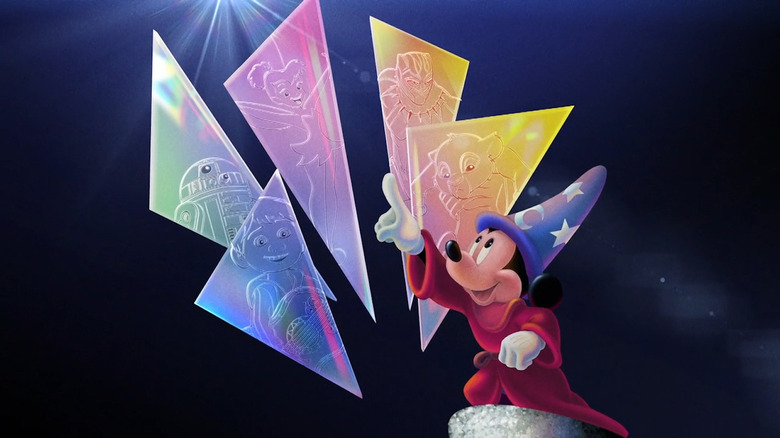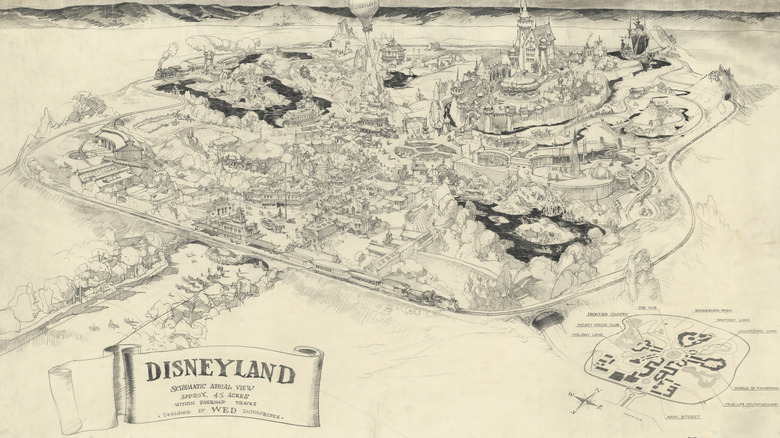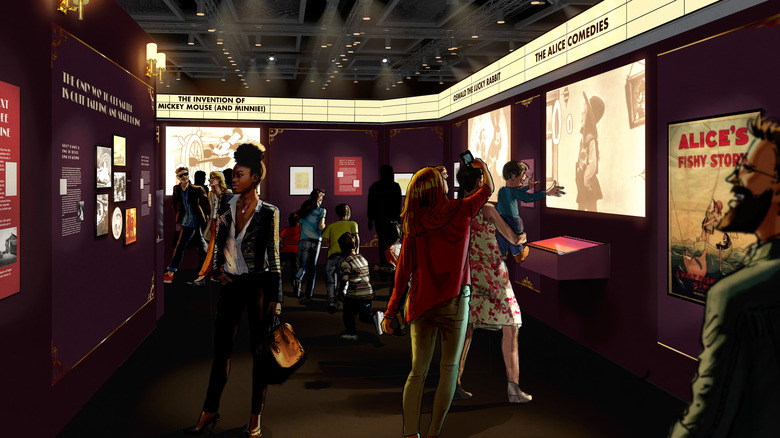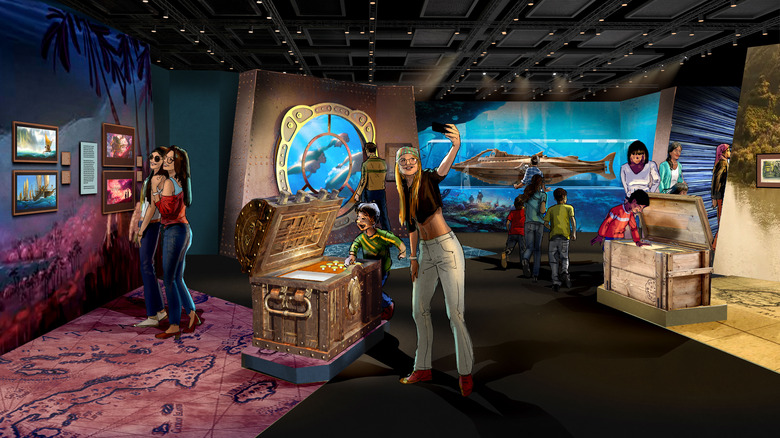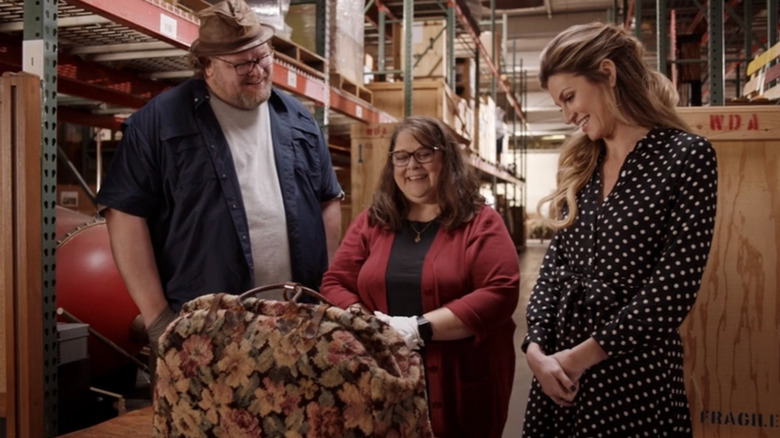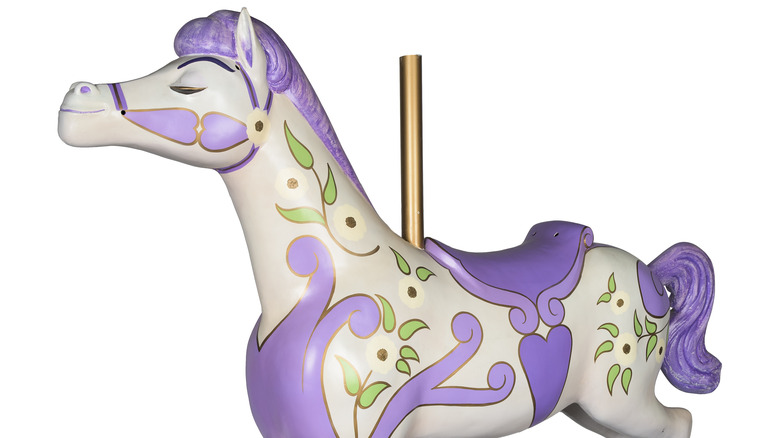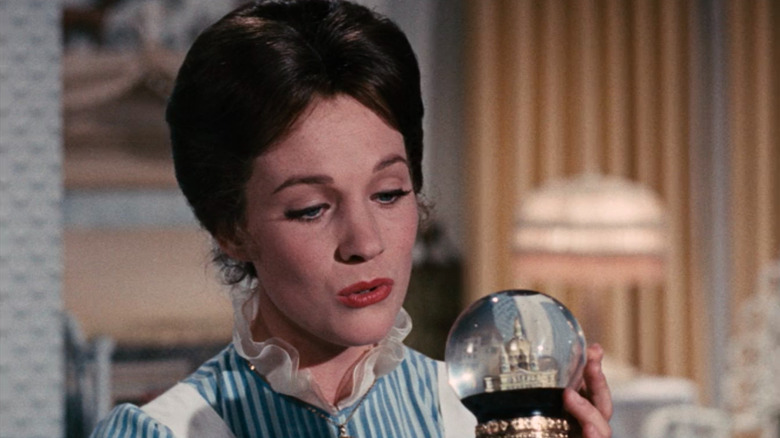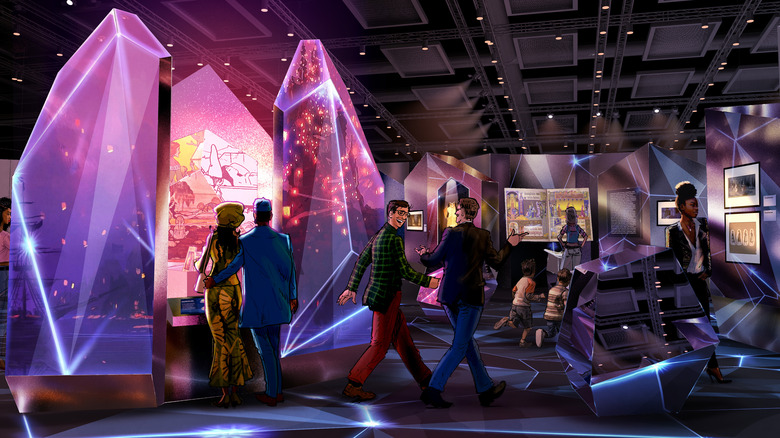Walt Disney Archives Director Becky Cline Takes Us Into The Disney Vault For Disney100: The Exhibition [Exclusive Interview]
When I was a kid, I remember hearing about the Disney Vault. Every once in a while, movies and shows would be brought in and out of this vault, apparently for special occasions. But this was very much a marketing tool to drum up the popularity of classic productions from The Walt Disney Company. There wasn't a literal vault where these things were kept ... right?
Well, in a way, there actually is a "Disney Vault." The Walt Disney Archives is an initiative that was started by Roy O. Disney in 1970 in order to collect and preserve the legacy of the company started by his brother. Over 50 years later, this archive (largely due to the groundwork laid by original Disney archivist Dave Smith) has assembled integral pieces of history from the House of Mouse's existence like props, costumes, and documents and ensures that they're kept safe and intact for future generations to enjoy.
But another key part of the Archives' mission is to bring these items to the people that love and cherish them and the memories associated with them. That's why archive director Becky Cline and her team created "Disney100: The Exhibition" for the company's centennial celebration this year. Making its world premiere this month at the Franklin Institute in Philadelphia, Pennsylvania, this exhibit displays over 250 "Crown Jewels" from all across the Disney timeline in a 15,000 square foot space that takes fans from Walt's humble beginnings to today and beyond. But before the grand unveiling in the City of Brotherly Love, we had the pleasure of speaking to Cline about what we could expect in the exhibit and the work it took to bring it to life.
Note: This interview has been lightly edited for clarity and brevity.
'It's a pretty big group!'
When you say "Walt Disney Archives," many people are probably picturing the warehouse at the end of "Raiders of the Lost Ark." But that's not actually your office, right? The archive is actually spread out across multiple locations. Exactly how many facilities fall under your jurisdiction as the Director of the Archives?
Well, the archives itself is, like you said, spread out into offices, warehouse facilities, and storage facilities. Our main office is at the Walt Disney Studios in Burbank, California. It is the headquarters of the company, the studio, and so the corporate archives [are] located on the studio lot. And then we have a photo library located over on our campus in Glendale, which is where Walt Disney Imagineering and some of our other offices reside, [as well as another] storage and research facility.
We also have an office now in Culver City because 21st Century Fox became part of Disney a few years back. We still have offices there where our Fox archivist team, who are now part of the Walt Disney Archives, [handle] our photo library and some assets down there with an office for research. So we actually have those three offices, then we have offices connected to some of our warehouse facilities where we have our exhibits team, and our collections team, and some of our digital collections team. So it's a pretty big group! And we also now have two people that are permanently in Florida. We have an Archives East [that just] became official a few weeks ago.
'We have everything from index cards with handwritten notes to high tech digital scans'
As a collector myself, I know how difficult it can be to keep things organized and catalogued. With such a large collection spanning from iconic items to random ephemera, how do you keep track of everything and know where to find them when you're preparing for an exhibit like "Disney100: The Exhibition?" Is that where places like the Digitization Department come into play?
One of the things that is natural to think about is that different types of assets require different type of storage. For example, you wouldn't store documents in the same place that you're storing costumes, or large ride vehicles wouldn't be in the same place that your audio collection would be. So we do have various facilities where we have mainly props. We have locations where we keep samples of merchandise. We have our costume collections. We have collections of art and flat things that are a little more delicate. There are different places even within our warehouses where we store different types of materials.
But what we have done is organized our collections into these various locations based on their needs of the objects or the assets. And then we cataloged them in, up until recently, up until about the last three or four years, a File Maker Pro database. Or by hand in the old days. We've been around for 50 years, so we have everything from index cards with handwritten notes to high tech digital scans and data asset management systems. But we're very excited because we are in the very final phases right now of a new collection management system that will encompass all of our collections in one big database that we can cross-reference and link them together so that we can look up information about the objects with images of the objects and also their location.
And it'll keep track of where everything goes, when it's on loan, when it's on exhibit, if it's resting, if it needs conservation. All of this big system that we've just developed and spent, I think, the last five years creating is brand new for us. We're really very excited about stepping into the next century, even though we're 20 years into it, to be able to do something really high tech to keep track of our assets. It's really an exciting experience.
'Storytelling is at the heart of everything we do'
Speaking of the exhibit, you mentioned in an interview while promoting "Adventure Through The Walt Disney Archives" that storytelling is at the core of everything you do. How do you go about deciding which pieces fit into the story you're telling in an exhibit like this that is meant to span the entire history of the Walt Disney Company? For example, why display Captain America's shield from "Captain America: Civil War" versus the one from "Captain America: The First Avenger" or "Avengers: Endgame?"
We've been working on this exhibit for over four years and that was the very first thing that we had to figure out. We're telling a story that's 100 years of history in 15,000 square feet. How do you do that? The other thing is to know your audience. We had to know that we're going to have everybody from two or three-year-old toddlers to grandparents and great-grandparents, and everybody's going to want to see the things that are most beloved to them. We don't want to tell a chronological story because then the older generation sees their favorite things at the beginning and then the kids have to wait until 10 galleries in to see the things that they love on streaming today.
Chronological would be the easiest because you just tell the story in order. But we thought, no, we don't want to do that. And so we took a step back and we thought [about] what themes, philosophies, and policies has the company used throughout its entire 100-year history. Of course, it started with Walt Disney. We may use new tools and new technologies, but we're still following Walt's footsteps. We looked at that and we thought [about] the basic philosophies that Walt Disney used and developed in the '20s up through his lifetime, ending in the late '60s, and how have we used those things continuously since. What are we doing today that follows those steps? It turned out that it was very simple, actually.
As you said, storytelling is at the heart of everything we do. So there's one gallery that's all about storytelling. It's a mixture of storytelling from "Snow White and The Seven Dwarfs" up to "The Princess and The Frog," [then] some of the newer titles that we're doing. It encompasses not just Disney, but Pixar. And of course, we wanted to give a nod to some of the others. This is mostly about Disney. It's the anniversary of Disney. But we do want to give some nods to Marvel and Lucasfilm, who also follow the same process. They use storytelling in everything they do.
What we decided to do is have a prologue, which is really exciting. There's a lot of clips. We have four dozen monitors and there's about 318 Disney films represented in the exhibit. But we start with a prologue. We go into where it all began and tell the early story of Walt Disney. There are people who don't know that Walt Disney was a real person, so we tell his story, who he was, and how he started the company in 1923, signing a contract for the Alice comedies. We show some of the silent films and the birth of Mickey and some of the early technology of the ["Silly Symphony" shorts].
But from there, we move right into storytelling. That's the next gallery. Then every gallery after that represents another philosophy, like the importance of personality in animation and our development of our characters, [or] the importance of music in Disney films and television and productions. The importance of the world around us, how we represent nature, how we show real nature, and how we represent nature in our fantasy and in our films. The importance of innovation — Innovention, as we call it. We represent a day in the park. And then we also want to share the fan experience of what Disney means to the people who have been the most important part of what we've done for 100 years [by] bringing alive their memories and explaining how you take Disney home with you by buying a record album, or you go to a movie theater, or you visit one of our parks or one of our live experiences. But we wanted to show it from the audience's point of view and show how much they've loved it over the decades.
Of course, the very last gallery is a look forward and it shows how we're still doing all of these things that Walt set up in the '20s. We're still doing them today and we do them in all of our brands, not just Disney, but in Marvel and Lucasfilm and Pixar, and other brands like ABC and Fox and other things that are a little newer to the company.
'There are so many really terrific assets in this exhibit'
That basically answers my next question, because I was wondering about those newer brands like Fox or The Muppets or Lucasfilm and how they would be incorporated into the exhibit since they're technically now part of Disney history. But you did say that the exhibit is mostly focused on Disney itself.
It is. That was our direction that we came up with early on. We wanted to focus on the Disney characters, and Disney Pixar, and our animation, but also our live-action films and things like that. But we wanted to focus on our family friendly brands and the stories that fit in. Marvel and Star Wars fit just as well as Pixar and Disney into that storytelling and into those categories. So yeah, there's a few nods. There's a little bit of National Geographic, there's a little bit of ABC, so we pay homage. But with 100 years of experiences of products and productions and things, it's really hard. You have to cherry pick. [But to answer] your question, how do you pick the assets? That was important too. Once we had that kind of framework in place, then we went through all of the vast collections that we have of the archives and decided which objects will tell that story best.
You go into the room, which is called the Spirit of Adventure and Discovery, and it's all about exploration and adventure. So we have the Nautilus from "20,000 Leagues Under the Sea," and we have costumes from "Jungle Cruise" and from "Pirates of the Caribbean." And artwork from "Moana" and other really exciting, beautiful artwork. And that was the area where we wanted to focus on. Not just on Walt Disney space shows of the '50s, but also "Star Wars" and the Marvel Universe. And it's really kind of cool how they all fit together, even though they're such separate and distinct brands within Disney.
There are so many really terrific assets in this exhibit. And it was really fun picking them out, but it was also like picking out your favorite children. We had to make some hard decisions.
'We're not the Disney police'
As we learned from "Prop Culture" on Disney+, many items in the archive, like Mary Poppins' carpet bag, are acquired from or with assistance from passionate collectors like Dan Lanigan. But I imagine that some collectors don't want to let go of marquee pieces of their collections. What have been some of the most difficult artifacts to acquire for the archive?
That's a question I get asked all the time. We're not the Disney police. I'm not the person who goes out because you have that and we need it back. That is not what we do. I'm really excited to get to know the people who love these things so much that they collect them. And in many cases, we just develop relationships with those people so that we have access to them. If we're doing a television special like "Prop Culture," Dan might have something in his collection and we have something in ours, but to tell the full story, it's really great to know who has those things and have a relationship with them so that down the road, if we want to tell a story and we don't have the assets in our collection, we can call on our friends and co-enthusiasts to bring those things to the fans.
That's really all I care about. Just knowing that the assets have a good home and they're being cared for. And having access to them is wonderful to us. We don't have to have everything in our hands, but it's really wonderful when we can work with people like Dan Lanigan and other collectors who have this because they're passionate about them. I'm just glad to see these things being taken care of.
While we're talking about Dan and his amazing Disney+ show, would you happen to know if we going to get another season of "Prop Culture?"
I'm working on it! I'm working on it, because I would love to do another season. We'll see what happens.
It was wonderful to do it, because as part of that show, they helped us restore some things. That was one of the fun things to see, the neon sign from Flynn's Arcade [as seen in "Tron"] get restored. Now it works again, so we can take it and exhibit it and fans can enjoy seeing it. It actually works! Or the "Honey, I Shrunk the Kids" shrinking machine, getting that put back into its original condition with the help of the people who created it originally. That really helps the archives to do things like that.
'What's the use of having it if you don't get to share it or see it?'
Speaking of Wayne Szalinski's shrink ray, you've mentioned publicly that one of your favorite pieces in the archive is the storybook from the beginning of "Sleeping Beauty." We'll get to see that in "Disney100: The Exhibition," but before it gets to the Franklin Institute, it was also restored to its former glory. What factors go into the decision to restore an item like that or the shrink ray, as opposed to leaving them as is, like the carousel horse used by Dick Van Dyke's Bert in "Mary Poppins?"
It's an interesting idea. First and foremost is what the asset itself needs. We want to make sure that we do preservation and conservation to keep the asset [intact]. We don't want it to deteriorate any further. So that's the main concern. When we're looking at it strictly from that angle, is looking at what the asset needs to have done to it to preserve it and keep it for posterity. Then the other aspect is, I firmly believe that The Walt Disney Archive's mission is to protect, preserve, and share the history of The Walt Disney Company. It's not just to hide it away in a box in a dark corner, which is probably the best for the asset. It's also to keep it up, to fix it if need be, but we also want to share it. The exhibitions program that we started has become so important to us because it allows us to share those wonderful assets with the people who love them the most. My having it in a warehouse off in some distant corner may keep it and protect it for a long time, but what's the use of having it if you don't get to share it or see it?
There are no hard and fast rules about which pieces get conserved. It may be that something we acquire that's new needs conservation before something we've had for 20 years. We look at everything and we put dates on these and say, "Let's look at this and see when it needs conservation." But maybe something that's made out of paper is more fragile. A piece of art will fade or photograph will fade. So maybe it needs attention before something that's pretty sturdy, like Bert's carousel horse.
And in some instances, we want to show the original artwork. I think it was done in the '70s, Mary's carousel horse was restored, was updated, and it looks really beautiful. It's pristine. But we didn't have Bert's carousel horse then. We acquired that, I think it was 2007 or 2008. I actually acquired that one for the archives and it hadn't been touched. It has the original painting on it, which we found out was done by [renowned matte artist and Disney Legend] Peter Ellenshaw. And so looking at it, it's like, "Well, do I want to change Peter Ellenshaw's artwork even though there are some rough spots?" We decided to keep that one in its original shape and then have the kind of pristine, new, pretty version of Mary's horse, which we were given. And so we have both of them and they look different, but they tell different stories.
'Everybody here at the studio cares so much about our history'
Staying with "Mary Poppins" for a moment, legend has it that the original Disney archivist, David Smith, found Mary's snow globe from "Feed the Birds" in a janitor's closet while looking for things to put in the archive. Are there any items that you've added to the collection over the years that you just so happened to stumble upon like that?
Oh my goodness! There's some things that were given to the archives in the early years that Dave knew they were there, but they hadn't been touched in 30 years. And none of us knew that they were there and they hadn't been completely cataloged or labeled or anything. So I've come across things that we didn't know we had that were pretty spectacular. The early days when Dave found the snow globe, that was a pretty special time because he was kind of given the keys to the studio and everything was stored in the basements and in attics of some buildings. He was able to just go through the studio and find everything that had been squirreled away. It's a little harder to do that now. We don't come across things very easily, but there had been a few little things here and there.
Interestingly enough, because the studio was built in 1939, the studio itself is elderly now. And so as some of the things get replaced, or buildings get updated or upgraded, it's really great now that the studio mill and the real estate people, they come to us and they say, "Hey, we have to remove this for various reasons. We have to put in fire sprinklers or something, but we don't want to lose the history." And they give them to us. We get things. We get furniture, we get original pieces, we get lighting fixtures. Even if a tree gets knocked down, the mill will lovingly take the wood and make something commemorative out of it and give it to the archives. It would say, "This tree used to be in front of the Personnel Building" or whatever it was. Everybody here at the studio cares so much about our history that it's just really lovely that we still get those kind of things. People call me out of the blue and say, "Hey, I found this in the closet." Things pop up all the time.
But I'm really excited you're talking about the snow globe. That's going to be in the exhibit. What's really exciting is that we're actually showing it in a new and immersive way. That's one of the special things about this exhibition is that there's a lot of interactives. There's over 14 interactives in this exhibit. Some of them are super high tech, some of them are simple for little ones. But one of the things that we're doing is trying to share assets and show them in a new way so that you can learn more about them and experience them differently. And the "Mary Poppins" snow globe is one of those.
'It's really thrilling and it's such an honor'
As you mentioned, one of your missions as part of the archive is to bring these artifacts to the people and share their stories. Special events like D23, "Disney100: The Exhibition," and other traveling exhibits definitely help in achieving that mission, but has there been any serious consideration for a physical Disney museum like the Rock n' Roll Hall of Fame?
Not to date. I mean, we've talked about the idea. When the archives were founded, it wasn't really planned to be any kind of a museum or even exhibits. It was mostly a document archive and a research and reference archive. We've kicked the idea around, we've talked about it. We're getting into these big scale exhibitions, which is pretty good. And of course, we support museum functions at our parks. If you go to Disney's Hollywood Studios, for example, the "Walt Disney: One Man's Dream" is there, and that's populated with assets from the Walt Disney archive. So we do have facilities that are museum-like within the company already. And we loan a lot of assets for events, but also for smaller exhibits around the company in various ways. But the idea of a brick and mortar museum, not on the table right now. But never say never.
Since the items under your care aren't just a company's history but also pop culture history and the personal histories of the fans that cherish them and the works they came from, is it ever overwhelming to think that you and your team are the ones that preserve the magic?
It can be a little daunting sometimes when you're taking on a new project. I don't think it's overwhelming. I've been doing this for 33 years. But it's exciting! It's really thrilling and it's such an honor. I mean, one of the high points of my career I consider is restoring Walt Disney's office. And now we're working on restoring Walt's plane. Those are things that are so important to the story of Walt Disney and the Walt Disney Company in general. And you're right, it is part of Americana and American history and world history, not just Disney's company history. But it's really fulfilling to have been part of that. And every time I get to start a new project and I see it actually happen, I get so excited.
So whether it's co-founding D23, or whether it's restoring Walt's office, or just conserving a piece of pottery from the '40s, I get very excited and I feel very fulfilled about it. I wouldn't say overwhelming. Sometimes the scale of everything we do ... I have to say I gulped a little bit when I found out we were taking over the Fox Archives as well. But you just kind of roll with it. And we have such an amazing team of very passionate people that it's never scary overwhelming. It's always just really exciting and a little daunting sometimes.
"Disney100: The Exhibition" debuts at The Franklin Institute in Philadelphia, PA on February 18, 2023. It will run until August 27, 2023 before moving to other North American cities such as Chicago, Illinois and Kansas City, Missouri and international cities like Munich, Germany on April 18, 2023 and London, England some time in the fall.
